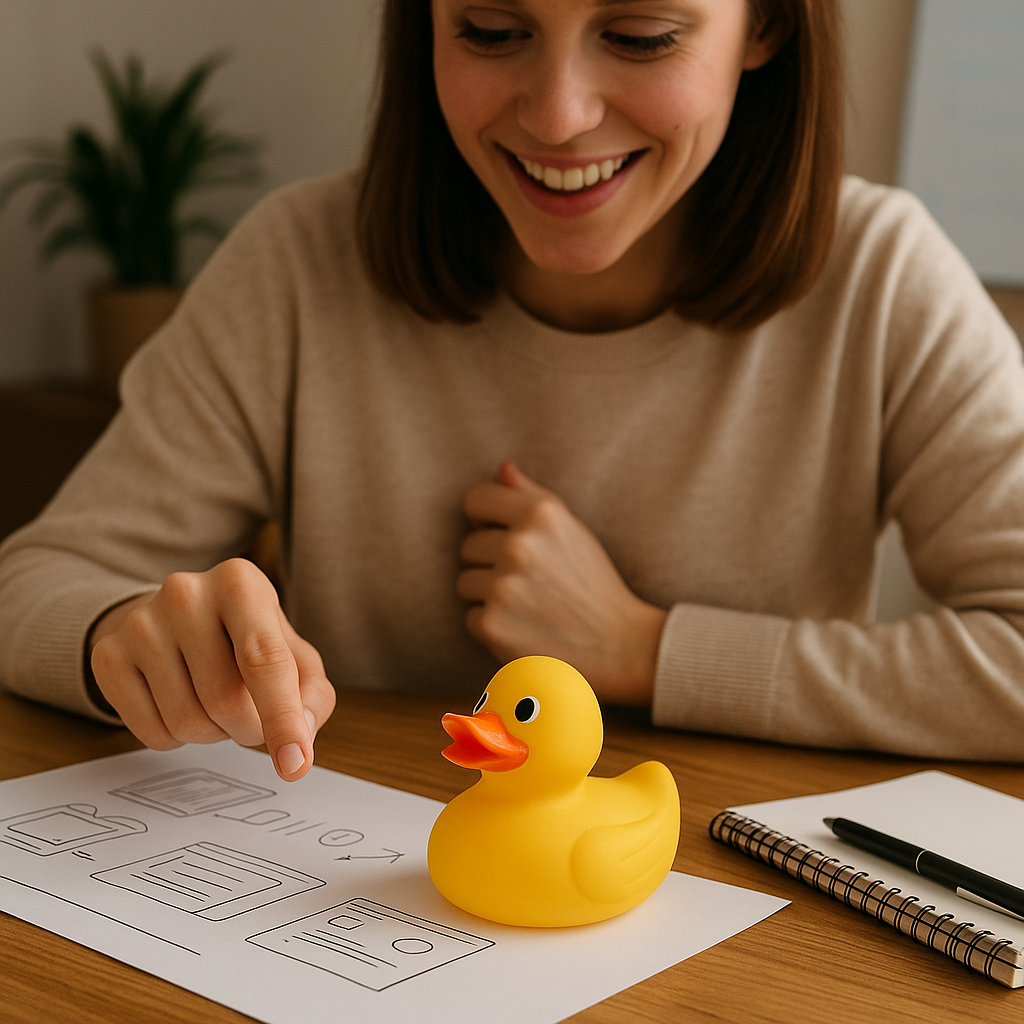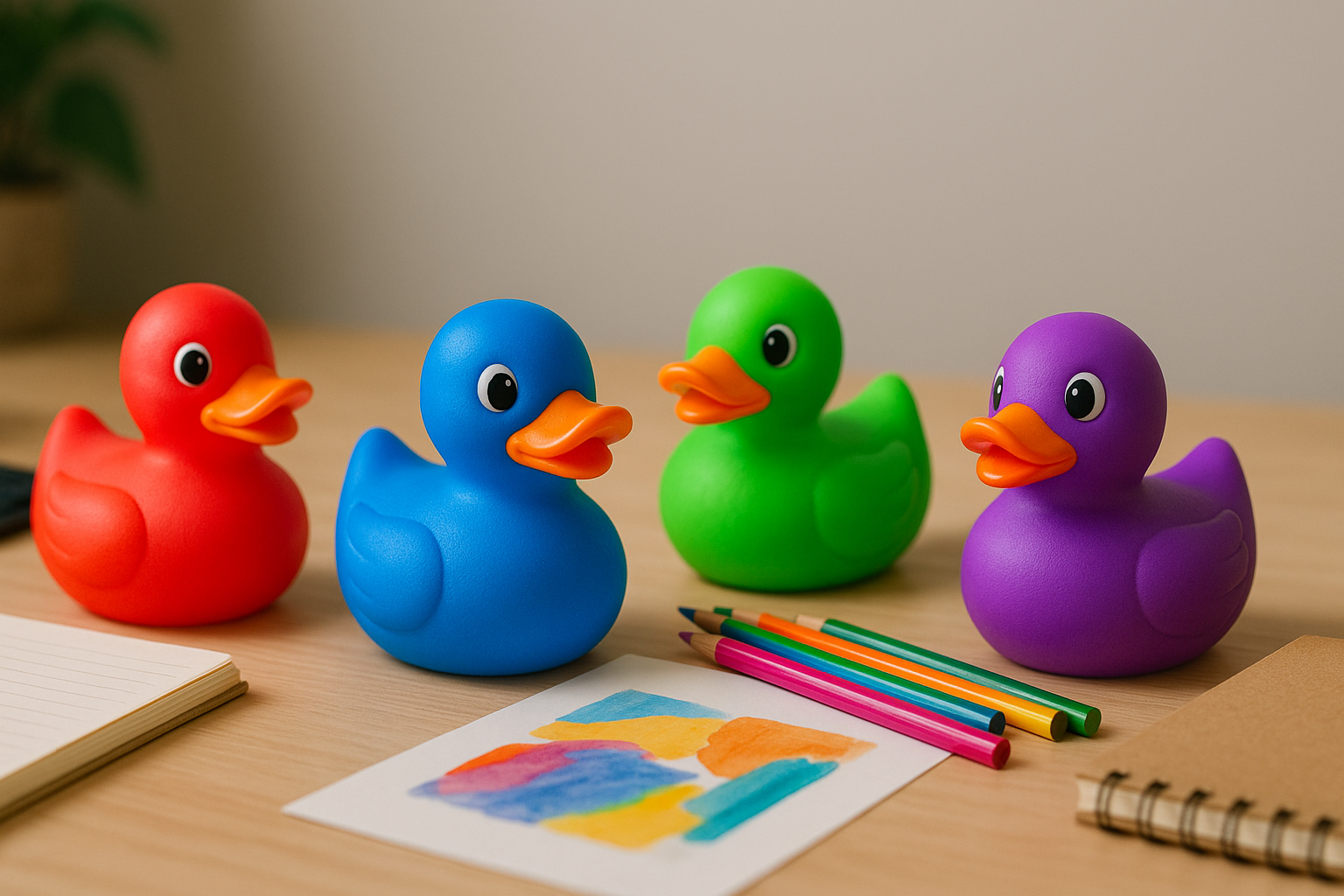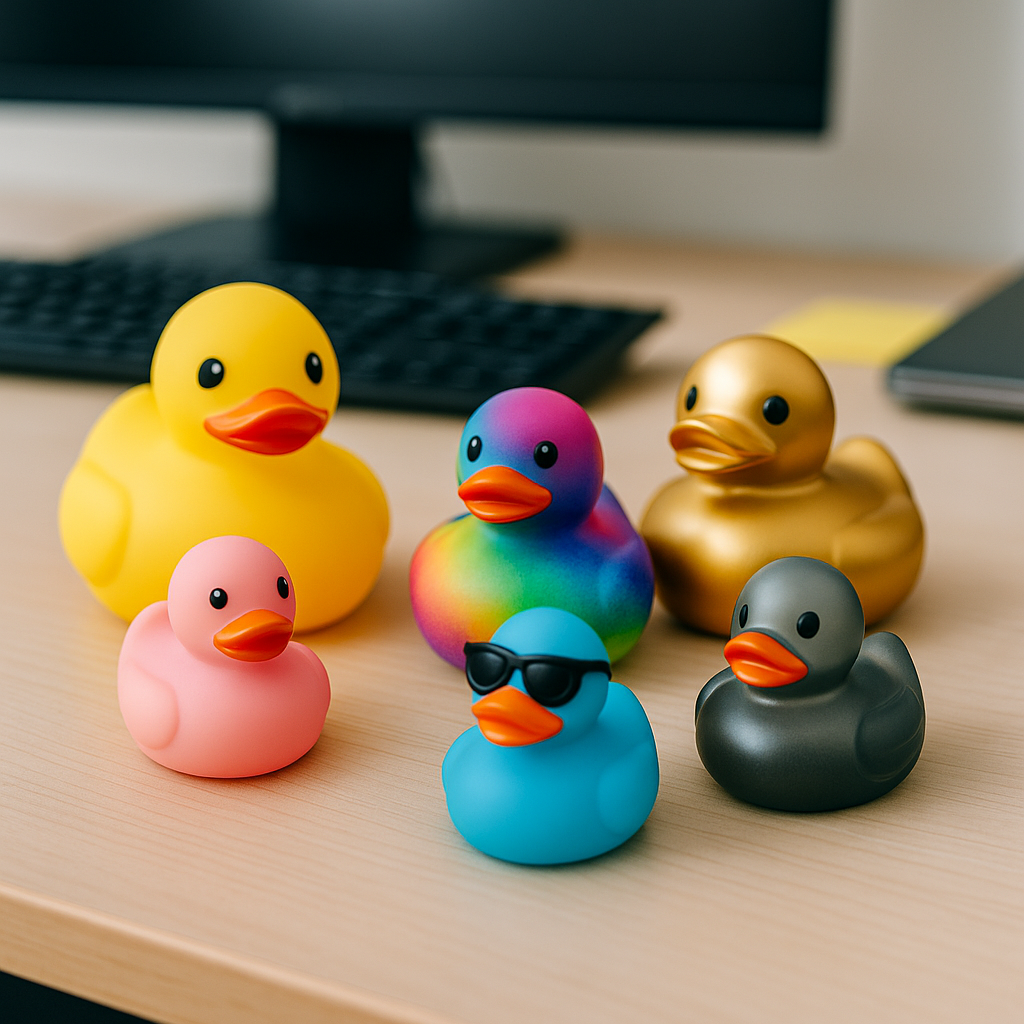Feeling stuck on a coding problem? Frustrated and staring at your screen? You’re not alone—and yes, that rubber duck might just help.
Rubber duck debugging[^1] is a problem-solving method where programmers explain their code line-by-line to an inanimate object, often a rubber duck.
Curious why developers have toy ducks next to their laptops? The quirky reason behind it is surprisingly effective. Let’s find out how it all started.
What is Rubber Duck Debugging and Where Did It Come From?
Ever had a moment when explaining something out loud suddenly made the answer clear? That’s rubber duck debugging.
Rubber duck debugging originated from the book “The Pragmatic Programmer[^2],” where a developer explains code to a duck to catch bugs.
Understanding the Origin of the Method
The term comes from a story in The Pragmatic Programmer, where a coder carries around a rubber duck and debugs code by explaining it to the duck. It’s a mental model, not a joke—though it sounds funny.
This technique taps into a psychological principle: explaining forces us to slow down and reprocess information. Saying things aloud activates different cognitive pathways. Many bugs become obvious once verbalized.
| Origin | Source | Year |
|---|---|---|
| Term introduced | "The Pragmatic Programmer" book | 1999 |
| Core method | Verbalizing code to clarify logic[^3] | |
| Main benefit | Detect hidden bugs in logic |
How a Simple Toy Became a Programmer’s Best Friend?
Developers often feel isolated during problem-solving. A rubber duck offers silent support and instant feedback—without judgment.
Rubber ducks help coders think clearly by acting as non-judgmental listeners[^4] during code reviews or debugging.
From Toy to Debugging Tool
Most coders don’t intend to form emotional bonds with plastic toys. But over time, the duck becomes part of their process. You don’t just talk to it—you rely on it.
This builds a ritual around coding. Some even dress up their ducks or give them names. It creates a sense of ownership and personalization, turning debugging into a less stressful process.
| Item | Role in Debugging |
|---|---|
| Rubber duck | Listener for code explanation |
| Office mascot | Symbol of thoughtful coding |
| Personal token | Reduces stress and loneliness |
Why Explaining Code to a Duck Actually Works?
Explaining helps the brain identify flaws, especially in complex systems. Saying it out loud forces clarity.
The act of explanation triggers higher-order thinking[^5] that surfaces logical inconsistencies and errors in your own reasoning.
Metacognition in Action
This technique is rooted in metacognition—thinking about thinking. When we describe our actions, we analyze them more critically. We notice what doesn’t make sense.
And the duck? It just listens. That’s key. No interruptions. No feedback loops. Just you, breaking down the logic—one function at a time.
| Process | Benefit |
|---|---|
| Verbal explanation | Identifies flaws in thinking |
| No interruptions | Encourages complete reasoning |
| Focus on clarity | Improves understanding |
The Psychology Behind Talking to Inanimate Objects
Humans often assign personality to objects—it’s called anthropomorphism[^6]. It’s a natural way to reduce stress.
Talking to inanimate objects can offer emotional comfort, increase focus, and help externalize internal thinking.
Cognitive and Emotional Benefits
People talk to pets, plants, even cars. It’s the same with ducks. It creates a low-stakes environment for thinking out loud. The duck doesn’t judge, interrupt, or misunderstand.
This creates emotional distance from the problem. And emotional distance is crucial for solving high-pressure issues—like debugging under deadlines.
| Behavior | Psychological Purpose |
|---|---|
| Talking to objects | Externalizes thinking |
| Assigning personality | Comfort and focus |
| Creating rituals | Builds consistent habits |
Do Non-Tech People Use Rubber Ducks for Problem-Solving Too?
Yes. Designers, teachers, and even marketers use them to clarify ideas and prepare presentations.
Rubber duck-style thinking has expanded into non-technical fields as a method for processing complex ideas or practicing speeches.
Beyond Programming: Universal Use
I’ve seen project managers rehearse pitches with ducks. I’ve watched graphic designers explain layout issues to ducks. The duck becomes a silent coach.
In essence, it’s about focus and flow. When you need a judgment-free way to talk through something, the duck delivers.
| Profession | Use Case |
|---|---|
| Teachers | Practicing lectures |
| Designers | Explaining user journeys |
| Entrepreneurs | Planning business pitches |
How Rubber Ducks Improve Focus and Reduce Coding Frustration
Coding is mentally exhausting. A duck adds a simple, calming routine that breaks the stress cycle.
Using a rubber duck can create a routine that grounds the mind, reducing anxiety and boosting focus during debugging sessions.
Habit-Driven Productivity
When frustration builds, productivity drops. A duck gives your brain a familiar process to fall back on. It shifts your mind into problem-solving mode.
This can prevent burnout. Even a few minutes of “talking it out” helps you approach problems with fresh eyes.
| Benefit | How it Helps |
|---|---|
| Routine | Reduces cognitive overload |
| Physical object | Grounds attention |
| Verbalization | Clears mental bottlenecks |
Desk Ducks: The Rise of Rubber Duck Culture in Startup Offices
Startup offices are quirky, open, and full of symbolism. The rubber duck fits right in.
Rubber ducks have become a popular desk companion in tech startups, symbolizing clarity, problem-solving, and coder culture.
A Culture of Ducks
I’ve visited coworking spaces where ducks line the windows. Some teams give out ducks to new hires. It’s not a joke—it’s part of the culture.
The duck represents not just debugging—but thoughtfulness. It says, “We care about clear thinking and solving problems the right way.”
| Startup Culture Element | Purpose |
|---|---|
| Desk duck gifts | Welcoming new hires |
| Office mascots | Team bonding |
| Branded ducks | Promotional giveaways |
Can a Rubber Duck Replace a Coding Mentor?
No—but it can help you prepare better questions and learn faster.
Rubber ducks support independent thinking, helping programmers structure thoughts before seeking help from mentors.
Complement, Not Replacement
Mentors provide guidance, experience, and wisdom. Ducks help you make sense of what you already know. Together, they’re a powerful combo.
By explaining to the duck first, you’re more prepared to ask mentors clear, informed questions. That saves everyone time.
| Role | Contribution |
|---|---|
| Rubber duck | Helps self-assessment |
| Coding mentor | Offers expert guidance |
| Combined use | Accelerates learning |
Creative Professions That Secretly Use Rubber Ducks for Brainstorming
Writers, artists, and product developers all benefit from the duck method.
Rubber ducks help creatives by acting as silent sounding boards, encouraging external dialogue and problem reframing.
Quiet Brainstorming Partner
In creative fields, brainstorming isn’t always loud and messy. Sometimes it’s quiet, personal, and weird. Talking to a duck is a way to test ideas in private.
It’s not about answers—it’s about articulation. That process sparks new perspectives.
| Creative Role | Duck Usage Example |
|---|---|
| Writer | Talking through plot issues |
| Product designer | Explaining UX logic |
| Illustrator | Verbalizing visual choices |
How to Choose the Right Rubber Duck for Your Work Desk
Size, color, and personality matter more than you’d think.
Pick a rubber duck that makes you smile, fits on your desk, and reflects your style—it’s more than decoration.
Personalizing Your Debugging Tool
I’ve seen ducks with glasses, superhero capes, and pirate hats. Yours doesn’t have to be standard yellow. The more it reflects your taste, the more likely you are to use it.
Even better? Get one with your company’s logo or brand message. It makes a great conversation starter at events or meetings.
| Feature | Consideration |
|---|---|
| Size | Fits comfortably on workspace |
| Style | Matches your personality |
| Custom branding | Adds team identity |
Conclusion
Rubber ducks help people think clearly, debug faster, and reduce stress—making them surprising allies in both tech and creative work.
[^1]: Understand how explaining code to a rubber duck boosts problem-solving skills for developers.
[^2]: Learn the origin of rubber duck debugging in the influential book "The Pragmatic Programmer."
[^3]: See how verbalizing code improves clarity and helps detect logic errors.
[^4]: Discover why having a non-judgmental "listener" like a duck enhances debugging rituals.
[^5]: Explore how higher-order thinking aids in identifying mistakes during complex tasks.
[^6]: Understand how anthropomorphism helps reduce stress and boosts focus during problem-solving.


















